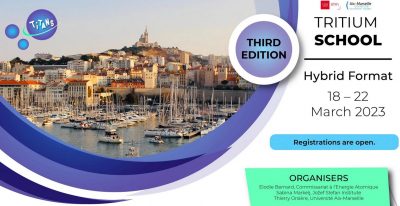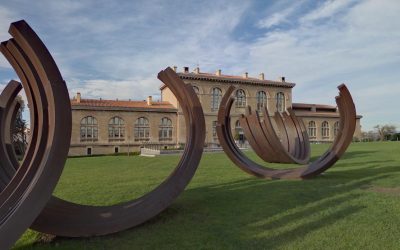
Group Member Ezequiel Goldberg attended the Third Tritium School, organized from 18 to 22 of March in hybrid format by the TITANS Project (Tritium Impact and Transfer in Advanced Nuclear reactorS). The project combines the expertise of international experts from material sciences, process engineering, biology, environmental sciences and modelling into a transdisciplinary project concentrating on the management of nuclear facilities, focusing particularly on tritium management. TITANS contributes to mitigating nuclear environmental impact, as well as facilitating the growing nuclear energy demand as Europe, and our world, transition to low-carbon energy sources.
The event consisted of invited lectures and contributed talks, encouraging young researchers in the fields of fusion and fission to participate, gaining knowledge and presenting challenges related to tritium management in fusion and fission facilities.
Hydrogen in the form of tritium plays a big role in the nuclear research community, and in recent years its importance has continued to grow. On one hand, most of the tritium in existence is created in nuclear fission reactors due to reactions with lithium, boron or deuterium. Naturally occurring tritium is extremely rare on our planet since it continually decays into Helium-3. Rather than a goal, tritium production in fission reactors is a side-effect and its recovery must be considered during the operation to enable its economic recovery and reduce potential contamination, being highly radioactive. On the other hand, tritium is an extremely important element to nuclear fusion reactors, since it is part of the fuel together with deuterium (which is a lot more abundant and not radioactive), in both magnetic and inertial confinement fusion. Deuterium-tritium is slated to be the fuel for ITER.
The Third Tritium School took place during 4 days of talks and discussions, with some attendees in person at the Palais du Pharo in Marseille and others connecting remotely. The topics comprised tritium management, inventory and control, waste management, radiotoxicity, ecotoxicity, epidemiology and dosimetry. Some of the talks that stood out covered the tritium fuel cycle in fusion reactors, tritium management at ITER and tritium processing in breeding blankets for DEMO. At the end of each day, there was a time slot dedicated to open questions and discussions of the several topics presented during the event.

The outlook of the event is that the importance of tritium in the nuclear reactor community will continue to increase. There are a lot of exciting research lines moving forward to understand the variety of processes that involve tritium, from its production to its recovery and its use. Scientific knowledge has advanced considerably, but there is still a lot of ground to be covered and a long way to go towards the goal of sustained nuclear fusion for energy production.
The Fusion Group thanks the TITANS Project for organizing this event allowing hybrid participation, and the speakers and participants for helpful insights and interesting discussions.
